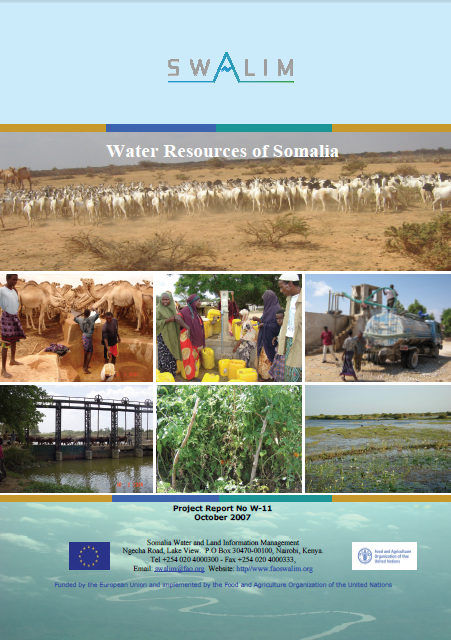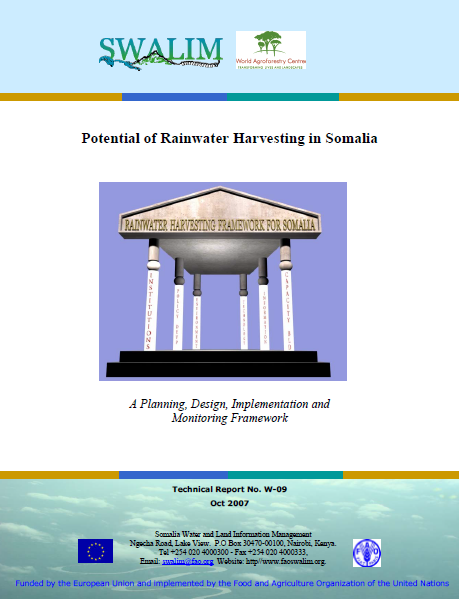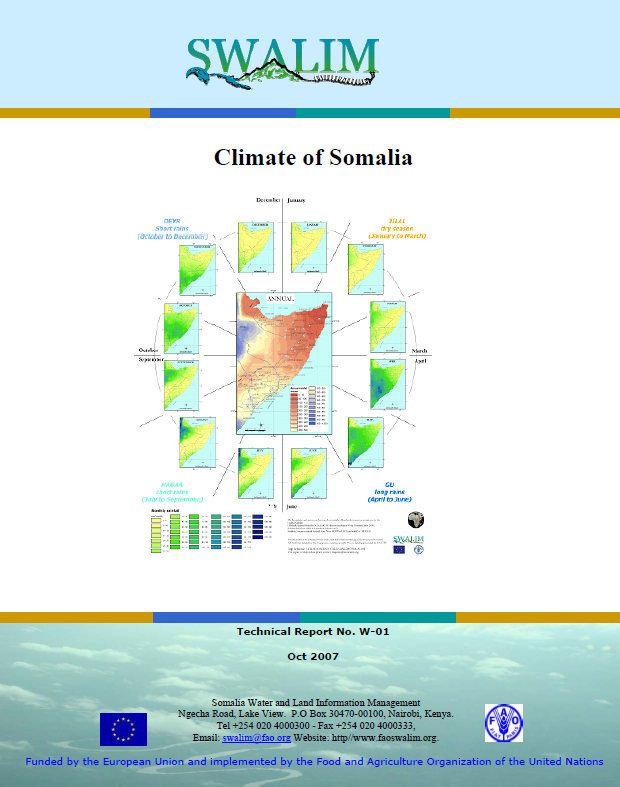Library Catalog
Latest Documents and Publications listed. Use search terms in the box below to find what you need
W-03 Diiwaagelin Xog cilmiyeed Biyo-hawo-saadaalin (hydro-meteorological data) ee Soomaaliya
Dalalka soo koraya; gaar ahaan Afrika, waxay wajahayaan caqabado waaweyn oo ka haysta maaraynta xogta iyo macluumaadka. Halka sida la og yahay in meeldhexe ka maareynta xogta gundhig ah ay dhaqan wanaagsan tahay markii ay arrin cilmi-baaris tahay, dalal aan badnayn ma maareyn inay ka guulgaaraan arritaan, inkasta oo uu kordhayo xaddiga aqoonta macluumaadka iyo farsamada isgaarsiinta. Soomaaliya waxay weliba wajahaysaa caqabado ka waaweyn kuwa dalalkaan iyadoo ay ugu wacan tahay dagaalka sokeeye ee daba dheeraaday. Hal iyo bar tobanaad sano oo dagaalka sokeeye ka jirey gudaha dalka wuxuu u keenay khasaare iyo dhaawac wax badan oo la xiriira macluumaad biyo & dhulka oo nus qarnigii hore la ururiyay. Warbixintani waxay soo bandhigaysaa diiwaangelin xog taariikheed cilmiyeed biyo-hawo-saadaalin (hydro-meteorological) taasoo laga ururiyay ilo kala duwan, iyo xogta hydrometeorological-ka hadda ay uruurinayso SWALIM iyadoo kaashanaysa hay'ado la hawlgala.
Publication Type:
Technical report
Publication Date:
Author:
Corporate Author:
W-05 Xaaladda Mashaariic Waraab oo Dhexdhexaad ilaa Waaweyn ah oo gudaha Koonfurta Soomaaliya ka jira
Inkastoo beeraha waraabka ay ahaayeen isha-nolosha dhaqaalaha Soomaaliya ka hor bilowga dagaalka sokeeye ee 1990, wax badan oo macluumaadkii hababka waraabka oo dagaal hortii jirey ayaa lumay oo wax yar ayaa la og yahay xaaladdooda hadda ah. Warbixintani waxay muujinaysaa natiijooyinka ka soo baxay qiimayn ay SWALIM fulisay si loo ogaado xaaladda mashaariicda waraabka dhexdhexaad ilaa waaweynka ah oo ka jira gudaha Koonfurta Soomaaliya iyo kaabayaashooda waraabka. Waxaa la fuliyay dib-u- eegis qoraallo dhammeystiran, wareysiyo dad muhiim ah oo lala xiriiray iyo falanqayn ballaaran oo ah xog jeedaalin dareeme fog si loo gaaro natiijooyinka qiimaynta. Waxaa la soo saaray macluumaad gundhig ah oo ku saabsan biyoxireennada, habab kanaal iyo mashaariic waraab dabaded waxaa la dhisay xog-gundhig GIS ah ee kaabayaasha waraabka.
Waxaa la ogaaday qiyaas 5000 km oo kanaalo ah markii barbardhig loola sameeyey masawirro dayax-gacmeed. Waxaa la aqoonsaday xuduudaha iyo xaaladda 34 mashaariic waraab oo dhexdhexaad ilaa waaweyn ah. Xogta si fiican ayaa loo habeeyay oo waxaa la heli karaa markii loo isticmaalo desktop GIS software ama software web ku salaysan oo Geonetwork ah. Natiijooyinka soo baxay, oo ay weheliyaan talooyin, ayaa waxaa la filayaa in ay aasaas u noqdaan dadaallada dayactirka kaabayaasha ee bulshada deeqbixiyaha.
Publication Type:
Technical report
Publication Date:
Author:
Corporate Author:
W-11 - Water resources of Somalia
The report is a synthesis of SWALIM water assessments and reports, supplemented by detailed statistical analysis of the temporal and spatial variability of the available surface and groundwater resources, and their existing and potential uses. The assessment is based on the integration of hydrometeorological and physiographic data collected and analysed by SWALIM and partner agencies. The assessment describes the existing major water resources in the country, identifies special water resources needs and opportunities, documents ongoing and planned water resources development activities; it suggests practicable approaches to short and long-term water resources development at mezzo-and macro scale. The report is intended to support integrated water resources management in Somalia, based on coordinated development and management of water and land related resources.
Publication Type:
Technical report
Publication Date:
Author:
Basnyat D, Somalia Water and Land Information Management, Nairobi (Kenya)
Corporate Author:
Somalia Water and Land Information Management, Nairobi (Kenya)
W-09 - potential of rainwater harvesting in somalia
Somalia covers an area of 637,657 km2 with the population in 2003 estimated at 7.5 million inhabitants. Somalia economy is predominantly agricultural (crops and livestock, the latter being a major mainstay). The economy depends highly on water availability, which in turn is reliant on rainfall. Rainfall in Somalia is not only low, below 100 mm per year in some areas, but has a high temporal and spatial variability (annexes 1 to 5). The annual average rainfall ranges from 215 mm in the North-eastern regions to approximate 550 mm in the South-Central regions (SWALIM, 2007). The water balance for the country depicts potential evapotranspiration greater than rainfall in the entire country. In addition, other hydro-physical conditions that negatively impact on the availability of freshwater include land degradation and siltation of water bodies. The situation has been compounded by 16 years of civil strife, especially in the southern regions. A number of local and international organizations have initiated civil reconstruction, environmental conservation and livelihood-support programmes. Experts estimate that Somalia is among the 13 African countries that will face water scarcity by 2025. A country is said to be water scarce when its annual per capita water availability falls below 1000 m3. Already, Somalia has less than 500 m3/per capita/year (UNECA, 2000). This is attributed to erratic spatial and temporal distribution of rainfall with average annual amounts falling between 100 and 800 mm, high evaporation, and human activities that exacerbate land degradation.
Publication Type:
Technical report
Publication Date:
Author:
Oduor A.R., Gadain H.M.
Corporate Author:
Somalia Water and Land Information Management, Nairobi (Kenya)
W-11 - Khayraadka Biyaha ee Soomaaliya
Warbixintu waa gunaanad SWALIM ee qiimayno biyood iyo warbixinno, lagu kaabay falanqayn tirakoob faahfaahsan oo ah kala duwanaanshiyo xilliile iyo midka masaaxadeed ee khayraadka biyood ee dusha iyo dhul-hoose laga heli karo, iyo isticmaalladooda hadda iyo ka suurogali kara. Qiimayntu waxay ku salaysan tahay is dhexgelinta xogta biyo-jawi saadaaleed iyo abuur-oogoo dhuleed (hydrometeorological iyo physiographic data) oo ay soo ururiyeen oo falanqeeyeen SWALIM iyo hay'ado hawl-la-wadaag ah.
Qiimeyntu waxay ka warramaysaa khayraadka biyaha ugu muhiimsan gudaha dalka, waxay cadaynaysaa baahiyo khayraad biyo gaar ah iyo fursado, waxay qoraysaa hawlo horumarin khayraad biyood oo weli-soconaya iyo kuwo la qorsheeyay; waxay soo jeedinasaa habab-raacyo suurtogal ah ee horumarin khayraad biyood oo muddo gaaban iyo mid dheer oo heer dhexdhexaad - iyo mid baaxad weyn ah isugu jira. Warbixinta waxaa loogu talagalay in lagu taageero maareynta khayraadyo biyo oo isku dhafan ee gudaha Soomaaliya, oo ku saleysan isku dubaridid la xiriirta horumarin iyo maarayn khayraad biyood iyo dhul.
Publication Type:
Technical report
Publication Date:
Author:
Corporate Author:
W-01 Climate of Somalia
Somalia generally has an arid to semi-arid climate. Rainfall is the defining characteristic of the climate and has a great spatial and temporal variability. The climate of Somalia is determined by the north and south movement of the inter-Tropical Convergence Zone (ITCZ). In most areas of Somalia this results in two rainfall seasons - the Gu as the zone passes northwards and the Deyr as it moves south. In both cases, rain is produced from the moist air derived from the Indian Ocean, in the southerly air stream. The north-easterly winds, emanating from Asia and Arabia, produce little significant rain. It is generally considered that rainfall is the most important meteorological element affecting life in Somalia. In particular, variation from season to season, and variations within the season are what determine the successes of agricultural activities.
Publication Type:
Technical report
Publication Date:
Author:
Muchiri P.W.
Corporate Author:
Somalia Water and Land Information Management, Nairobi (Kenya)
W-05 Status of Medium to Large Irrigation Schemes in Southern Somalia
Although irrigated agriculture was the life-line of the Somali economy before the start of civil strife in 1990, much of the information on the pre-war irrigation systems is lost and little is known about their present status. This report documents the findings of an assessment carried out by SWALIM to determine the status of medium to large irrigation schemes in Southern Somalia and their irrigation infrastructure. Comprehensive literature review, key contact interviews and extensive remotely sensed data analyses were carried out to arrive at the assessment results. Baseline information on the water barrages, canal systems and the irrigation schemes was generated and a GIS irrigation infrastructure database was constructed. About 5,000 km of canals were identifi ed and compared with satellite images. The boundaries and the status of 34 medium to large irrigation schemes were identifi ed. The data is well structured and accessible through desktop GIS software or through the web based Geonetwork software. The results obtained, together with the recommendations, are expected to form the basis for the infrastructure rehabilitation efforts by the donor community.
Publication Type:
Technical report
Publication Date:
Author:
Muthusi F.M., Gadain H.M., Mbara C.J.
Corporate Author:
SWALIM
W-08 Rural water supply assessment
Water resources in Somalia are limited both in quantity and quality, with frequent droughts and floods further worsening the water security situation in the country.
Before the onset of civil war in early 1991, the main institution in charge of water resources management in Somalia was the Ministry of Water and Mineral Resources (MWMR) through the National Water Centre (NWC). Exploitation of domestic water supplies was the responsibility of the Water Development Agency (WDA), while the ministry of Agriculture planned and operated water for agricultural activities in the Shabelle River. For the Juba River, development was the responsibility of the Ministry of National Planning and Juba Valley Development. Institutional arrangements of water resources management showed fragmentation, without a clear divide between the functions of national and local agencies. With the outbreak of civil war in 1991, much of the water infrastructure in Somalia was destroyed and social services such as health,education, water and sanitation were seriously affected.Being located in an extremely water-scarce area, the environmental, social and economic
development of Somalia is to a large extent dependent on improved water security through effective management of water resources.
Publication Type:
Technical report
Publication Date:
Author:
Muthusi F.M.
Corporate Author:
Somalia Water and Land Information Management, Nairobi (Kenya)
W-01 Cimilada Soomaaliya
Soomaaliya guud ahaan waxay leeday cimilo u dhexeysa oomane iyo mid bar-oomane ah. Roob-da’u waa sifo qeexeysa cimilada oo waxay leedahay kala duwanaasho weyn oo masaaxadeed iyo mid waqtiyeed. Cimilada Soomaaliya waxa ay ka abuuranta kulanka dabaylaha ka soo dhaca waqooyiga iyo koonfurta aagga dhulsooraha (inter-Tropical Convergence Zone (ITCZ)). Meelo badan oo gudaha Soomaaliya ah waxay tani ka dhalisaa laba xilli roobaad – Guga marka aaggu gobolku xagga waqooyi iyo deyrta marka uu u wareego koonfur. Labada xaaladoodba, roobku wuxuu ka dhashaa dabaysha qoyan ee ka timaadda Badweynta Hindiya, marka dabayshu u dhacayso xagga koonfureed. Dabaylaha waqooyi-bari, ka soo dhacaya Aasiya iyo Caaraabiya, waxay dhaliyaaan roob aan badnayn. Waxaa badanaa la aaminsan yahay in roob di’iddu tahay waxa ugu muhiimsan cimilada oo saamaynaya nolosha gudaha Soomaaliya. Si gaar ah, isbedel xilli ka xilli, iyo isbedello isla xilliga gudihiisa waxay yihiin waxa go’aamiya guulaha hawlaha beeraha.
Publication Type:
Technical report
Publication Date:
Author:
Corporate Author:
W-08 Qiimaynta biyaha Miyiga
Khayraadka biyaha gudaha Soomaaliya waa ay kooban yihiin tiro iyo tayo labadaba, taas oo ay weheliso abaar soo noqnoqda iyo daadad sii xumeeya xaaladda ammaanka biyaha ee gudaha dalka. Ka hor bilowgii dagaalka sokeeye ee horraantii1991, hay'adda ugu muhiimsan ee mas'uul ka ah maaraynta khayraadka biyaha gudaha Soomaaliya waxay ahayd Wasaaradda Khayraadka Biyaha iyo Macdanta iyada oo loo marayo Xarunta Biyaha Qaran. Manaafacaadsiga biyo siinta maxalliga waxaa mas'uuliyad ka saarnayd Hay'adda Horumarinta Biyaha (WDA), halka Wasaaradda Beeraha ay qorshayn jirtey oo ka shaqayn jirtey hawlaha biyaha waraabka beeraha ee wabiga Shabeelle. Marka ay noqoto Webiga Jubba, horumarinta waxaa ka mas'uul ahaa Wasaaradda Qorshaynta Qaranka iyo Horumarinta Dooxada Juba. Qabanqaabooyinka hay'adeed ee maareynta khayraadka biyaha waxay muujiyeen kala qoqobnaan, oo aan lahay xad cad oo u dhexeeya hawlaha hay'adaha qaraniyo kuwa maxalliga ah. Markii uu qarxay dagaalkii sokeeye ee 1991-kii, wax badan oo ka mid ah kaabayaasha biyaha waa la burburiyay oo waxaa si xun loo waxyeeleeyey adeegyo bulshadeed oo ka jirey gudaha Soomaaliya sida caafimaadka, waxbarashada, biyaha iyo fayadhowrka. Maadaama Soomaaliya ay ku taal geyi aad u biyo-yar, horumarinta deegaameed, midda bulshadeed iyo dhaqaalaba waxay si baaxad weyn ugu tiirsan tahay ammaan biyo la hagaajiyey oo maareyn khayraad biyood oo wax-ku-ool ah leh.
Publication Type:
Technical report
Publication Date:
Author:
Corporate Author:
Pages
 RSS feed [compliant with the Agris AP] |
RSS feed [compliant with the Agris AP] |  Agris AP XML
Agris AP XML




